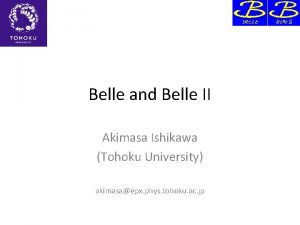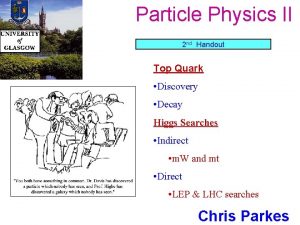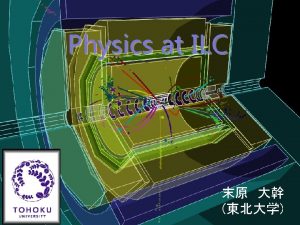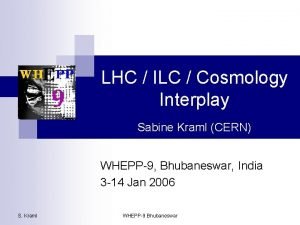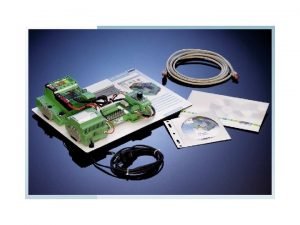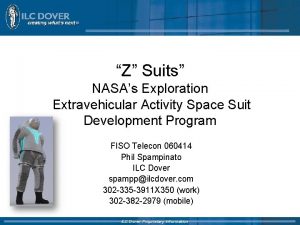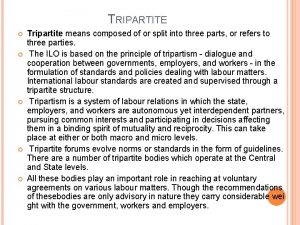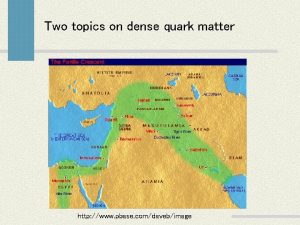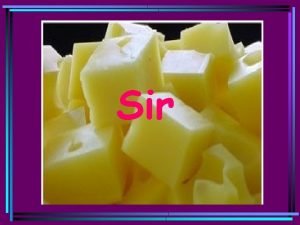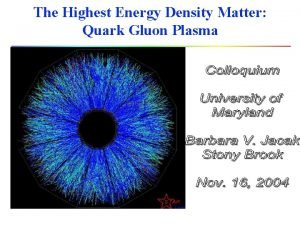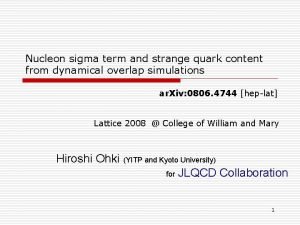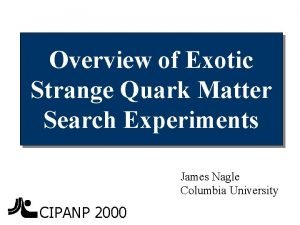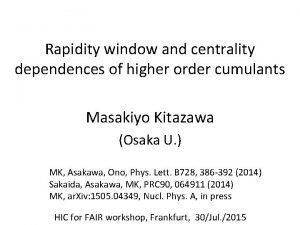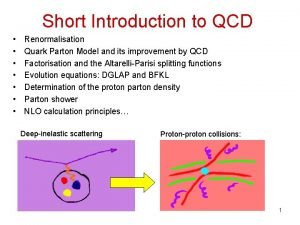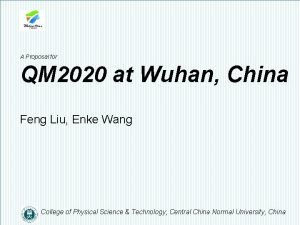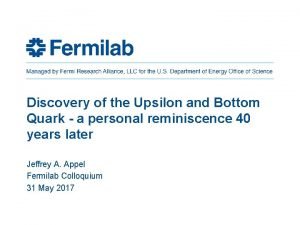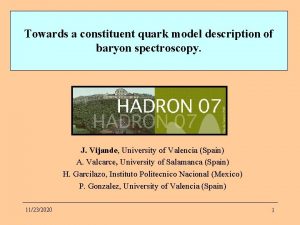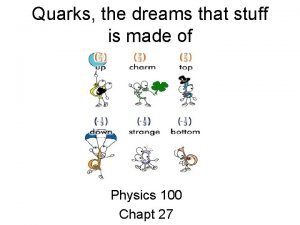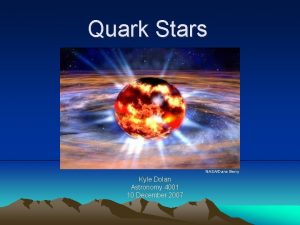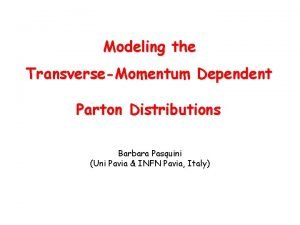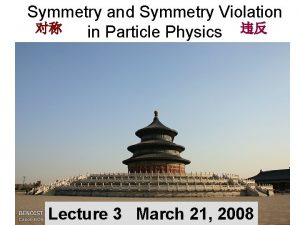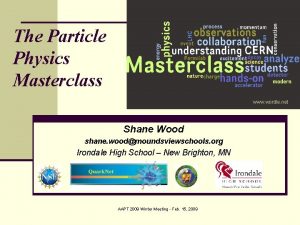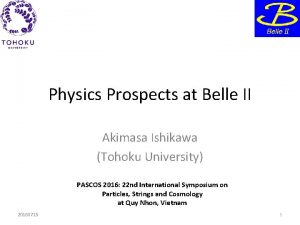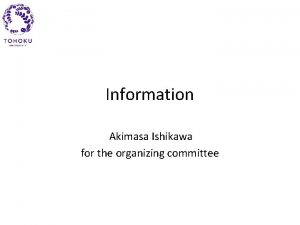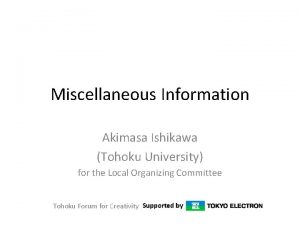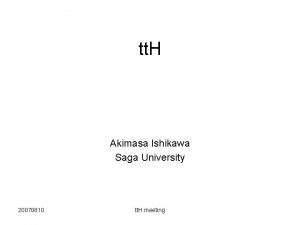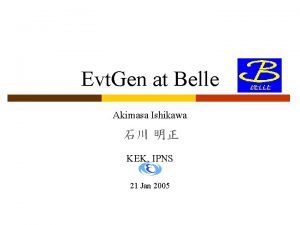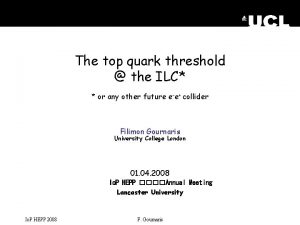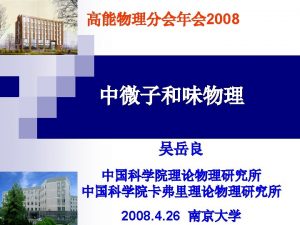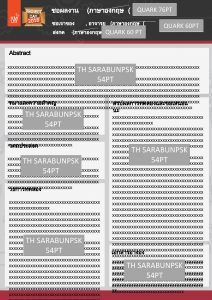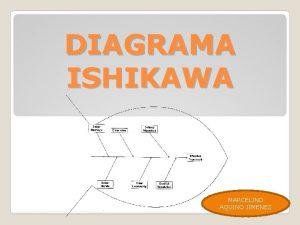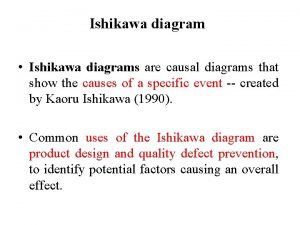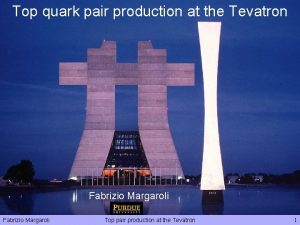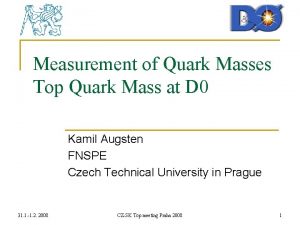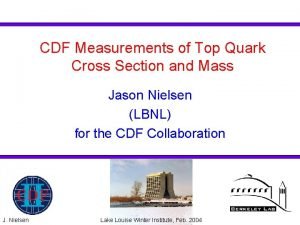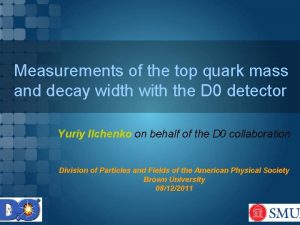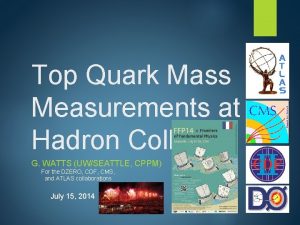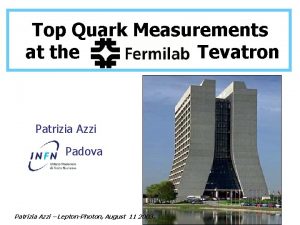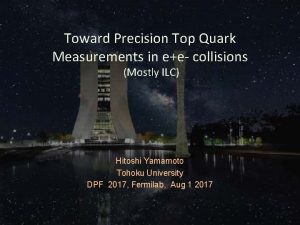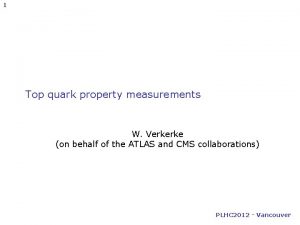Top Quark Measurements at the ILC Akimasa Ishikawa

























- Slides: 25

Top Quark Measurements at the ILC Akimasa Ishikawa (Tohoku University)

Introduction • Top quark is the heaviest elementary particle. – mt = 173. 1 ± 0. 9 Ge. V • The mass is close to EW scale v/√ 2 = 174 Ge. V (yt ~ 1) – Top quark may play an important role in EW symmetry breaking • Top quark decays before hadronization – Lifetime is about 5 x 10 -25 s – Can probe bare quarks

Top Quark at Hadron Colliders • Top quarks are only studied at hadron colliders. – Top quarks are produced from QCD reaction, dominantly quark pairs annihilation at the Te. Vatron or gluon fusion at the LHC. – Initial state energy/polarization is unknown – Theoretical uncertainty in QCD is large

Measurements at Hadron Colliders • The properties are partially known – Mass in pole “like” scheme which is hard to translate to mass in Msbar scheme : mt = 173. 1 ± 0. 9 Ge. V • From cross section : mt. MSbar = 160 +- 5 Ge. V – – Width with indirect method : Gt = 2. 0 +- 0. 5 Ge. V Spin and charges Coupling to gluon (to axigluon at the Te. Vatron? ? ) |Vtb|

Top quark at the ILC • Top quarks are produced from electroweak reaction – Theoretically clean – Experimentally easier to reconstruct • Tunable Beam energy and polarized beam – Threshold energy scan is possible – Chiral structure can be tested

Threshold Scan • The ttbar cross section is functions of several parameters • By scanning the threshold region, those parameter can be determined 9% enhancement Uncertainty of s ~4% ar. Xiv: hep-ph/9804241 Y. Kiyo We can measure top yukawa before going to Ecm=500 Ge. V 6

Experimental Cross Section Luminosity spectrum is not d function ! Th Cross section Need to convolute theoretical cross section with luminosity spectrum After Convolution Luminosity spectrum @350 Ge. V Experiment(toy MC) Convoluted theory 22 a. SD-5 2021/3/6 7

Assumptions for Threshold Scan •

Signal and Backgrounds Signal 6 -Jet Branching Fractions 4 -Jet 6 -Jet 45% 4 -Jet 44% 2 -Jet 11% Backgrounds e+e- WW, ZZ, ZH “LR” pol. “RL” pol. ttbar WW ZZ ZH 22 a. SD-5 2021/3/6 9

Top Yukawa • Enhancement due to Higgs exchange is 9% • Almost no Ecm dependence Y. Kiyo

Sensitivity to Top Yukawa : Case A Stat error 6 -Jet (Left) 6 -Jet (Right) 4 -Jet (Left) 4 -Jet (Right) Cross section 0. 8% 1. 2% 0. 9% 1. 3% Top yukawa 5. 0% 7. 2% 5. 1% 7. 9% Combined ALL 3. 0%

Fits to Mass and Width : Case A Clear discrimination of 200 Me. V differences for mass and width

Results on Mass and Width Input s mt. PS = 172 Ge. V Gt = 1. 4 Ge. V 6 -Jet 4 -Jet combined Stat error (Me. V) Left (110 fb-1) 23 29 24 30 --- Right (110 fb-1) 34 42 33 42 --- L+R (220 fb-1) 20 24 19 25 14 17 Stat error of top mass and width are 14 Me. V and 17 Me. V 22 a. SD-5 2021/3/6 13

Fits to Top mass and as : Case B PDG as = 0. 1184 ± 0. 0007 (0. 6%)

Vacuum Stability Current Status • Vacuum stability can be discussed with top mass and Higgs mass • Our vacuum might be meta-stable from current world averages of top mass and Higgs mass in the SM! – top mass from cross section • But the uncertainties on masses are large so we can not conclude the fate of our universe.

Vacuum Stability Future • Systematic error should be considered – Luminosity spectrum < 100 Me. V? ? – Theoretical uncertainty ~ 100 Me. V DMH = ± 37 Me. V Dmtpole = ± 17 Me. V Only Stat error. 22 a. SD-5 2021/3/6 16 Stat error of Higgs mass is by Watanuki with recoil with μμh

Form Factor Measurements • In Warped Extra Dimension model (bulk RS 1), wave functions of heavy particles are close to IR brane while wave functions of light particles are localized at UV brane. • Heavy top mass is explained by an overlap of right handed top quark and Higgs wave functions in the 4 th spatial dimension direction. – Couplings of left and right handed tops to Z is different • In some composite models, Higgs and top quark are composite. • These can be searched with form factor measurements

Form Factors • Only the SM are non-zero in • are dipole moment form factors. • Modified vertex could explain the discrepancy of AFB 0, b at LEP • Interference of g and Z allows a determination of relative sign. – Polarization are very powerfull tool – It is difficult at the LHC where form factors are measured from tt. Z and ttg

Angular Analysis • s(Ecm, qtop, qhel) • Top quark charge is measured with lepton (4 jet+lepton final states) • Polar angle of top quark can be measured with very small bias. – Forward-Backward Asymmetry • Helicity angle of top quark is also measured with small bias at +-1 that can be easily corrected. – Determination of a fraction of t. L and t. R – Right handed electron t. L enriched

CP Conserving Couplings • We assume Ecm = 500 Ge. V and 500 fb-1 – About 100, 000 top pair events. • From, differential cross section, CP conserving couplings are extracted • All couplings are measured less than 1% precisions – Which new physics parameter space is excluded? is fixed to zero

CP Violating Couplings • If 125 Ge. V is CP mixture states, a few % CP Violating couplings are possible at Ecm~370 Ge. V. • Has not been done at the ILC – Roman Poeschel, Yuichiro Kiyo et al started the analysis.

Summary • From a threshold scan – Measure top quark mass with 14 Me. V stat error which draws a definitive conclusion of vacuum stability in the SM • Systematic uncertainty is ~100 Me. V? • And higgs mass less than 50 Me. V – Measure top quark width with 17 Me. V stat error • Allows to search for anomalous couplings – Measure top yukawa before going to Ecm=500 Ge. V, tt. H production. • At higher energy, – Stat error of CP conserving form factors are estimated which is much better than LHC – One question to theorists. Which new physics parameter space is excluded?


backup

CP Violating Couplings at TESLA • But done at the TESLA
 Akimasa ishikawa
Akimasa ishikawa Top quark decay
Top quark decay Ilc brno
Ilc brno Ilc 2013
Ilc 2013 Spectrum ilc 1002
Spectrum ilc 1002 Ilc 150 eth
Ilc 150 eth David i
David i Zsuits
Zsuits Zora rutar ilc
Zora rutar ilc There are....tripartite committees at the national level..
There are....tripartite committees at the national level.. Quark gluon plasma
Quark gluon plasma Kako napraviti masni sir od kravljeg mlijeka
Kako napraviti masni sir od kravljeg mlijeka Quark gluon
Quark gluon Sigma quark composition
Sigma quark composition Quark matter
Quark matter Quark names
Quark names Quark gluon plasma
Quark gluon plasma Quark parton model
Quark parton model Quark matter 2022
Quark matter 2022 Quark names
Quark names Constituent quark model
Constituent quark model 6 types of quarks
6 types of quarks Quark astronomy
Quark astronomy Quark model
Quark model A charm quark has a charge of approximately
A charm quark has a charge of approximately Physics wordle quark
Physics wordle quark
